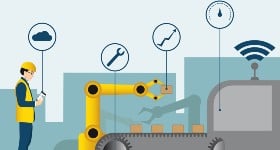
The industrial revolution changed us from a society of farmers to one of city dwellers and gave us access to wide range of specialized products produced by some new sectors of the economy. It allowed us more freedom in our choice of vocation and paved the way to the technologies of today.
We depend on industry to support our lifestyles, but it’s also severely damaging our environment — something that could threaten the way of life we’ve worked so hard to build. Along with conservation, politics, science and other fields, technology is now helping us to make industry greener. Here are five emerging technologies helping five different industrial sectors become a little more environmentally friendly.
Transportation - Inductive Power Transfer Systems
Cities can now use electricity to power their public transportation, which eliminates the need to use fossil fuels and avoids the emissions associated with burning them. Some of these buses and trams use batteries to provide the power they need. However, the power sources add significant weight to the vehicles, meaning they need to use more energy to move.
A company called Primove has addressed this challenge with a technology called inductive power transfer. It involves an induction coil in the ground below the vehicle's track. When electricity runs through the coil, it creates a magnetic field that produces a charge in a receiver in the machine, removing the need for a bulky battery.
Construction – Electrochromic Smart Glass
Heating and cooling account for almost half of the average U.S. home’s energy use, so making our buildings more efficient in this area can reduce environmental impact significantly. The growing green construction industry has begun designing buildings so that its windows let in sunlight to provide passive heating and lighting.
The issue, though, is that you can’t adjust this heating, potentially causing problems during the hot summer months. An emerging technology, electrochromic smart glass, might fix that problem. A building control system can adjust the amount of sunlight that this glass blocks. It can even tint automatically based on when the sun shines the brightest.
Manufacturing – Efficient Air Compressors
Many manufacturing plants use air compressors to run their equipment. Plant operators are discovering that a compressor designed to be more efficient can reduce energy costs by as much as 50 percent.
Quincy Compressor uses an integrated Variable Speed Drive (VSD) to automatically adjust speed so that the air flow output always matches demand, which means that the machine wastes much less energy. The company also offers an efficiency quotient process that operators can use to evaluate and improve the effectiveness of their compressed air systems.
Shipping - Sulphur Scrubber Systems
The ships used to transport goods around the world still use some fossil fuels, but the shipping industry is using technology to enable ships to burn that conventional fuel in a more environmentally friendly manner.
Ships now sometimes employ an exhaust gas scrubber system to reduce the amount of sulfur they release into the atmosphere. The best of these methods can decrease sulfur and other harmful particles in ship exhaust by up to 98 percent.
Food Production and Processing – Microbial Control Technologies
As the earth’s human population grows, so does the amount of food we produce and the impact this food production and processing has on the environment. Decreasing the amount of microbes in daily diet is crucial for human health, but the processes we typically use to do this, such as pasteurization, sterilization and the use of chemical preservatives, require a lot of energy.
Researchers are now exploring less energy-intensive methods for controlling for removing microbes from food. Some of these emerging techniques include microwave and radio-frequency heating, ultraviolet light treatment, pulsed electric fields (PEF), high-pressure processing (HPP) and ionizing radiation.
Green Technology Growth
Every industry has an impact on the environment, but new technologies are helping us to reduce the harm these industrial processes cause. We still have a long way to go, but these green advancements could prove to be crucial tools in our efforts to live more sustainably.
Edited by
Ken Briodagh





